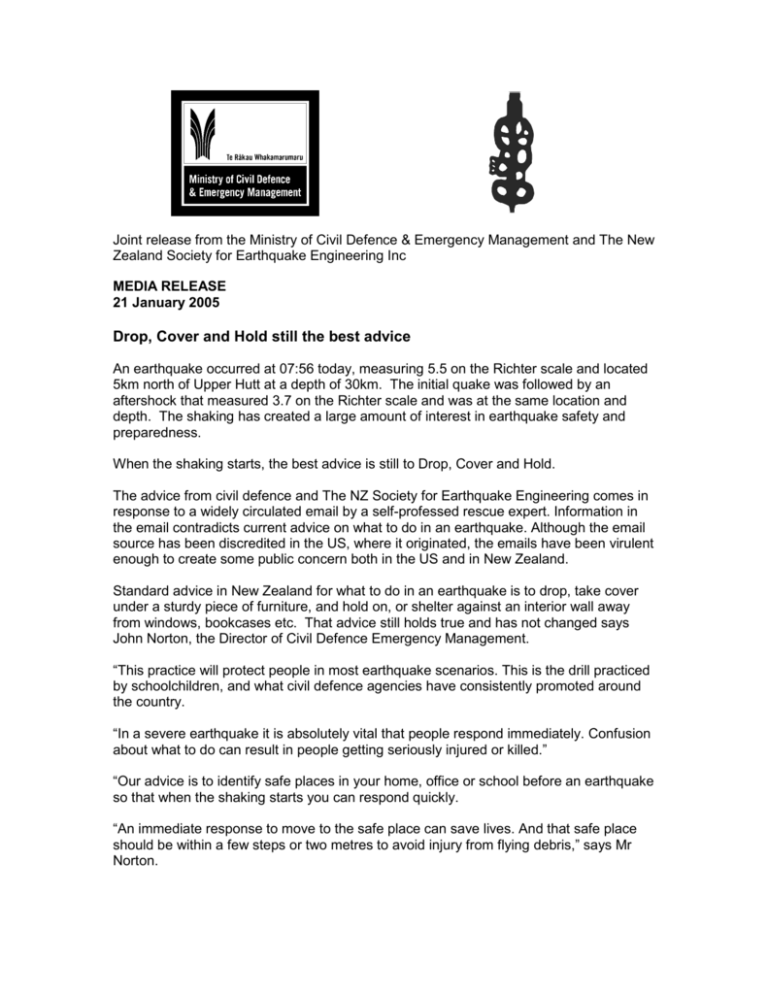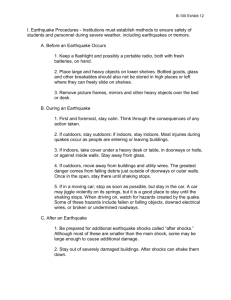Drop, Cover and Hold still the best advice
advertisement

Joint release from the Ministry of Civil Defence & Emergency Management and The New Zealand Society for Earthquake Engineering Inc MEDIA RELEASE 21 January 2005 Drop, Cover and Hold still the best advice An earthquake occurred at 07:56 today, measuring 5.5 on the Richter scale and located 5km north of Upper Hutt at a depth of 30km. The initial quake was followed by an aftershock that measured 3.7 on the Richter scale and was at the same location and depth. The shaking has created a large amount of interest in earthquake safety and preparedness. When the shaking starts, the best advice is still to Drop, Cover and Hold. The advice from civil defence and The NZ Society for Earthquake Engineering comes in response to a widely circulated email by a self-professed rescue expert. Information in the email contradicts current advice on what to do in an earthquake. Although the email source has been discredited in the US, where it originated, the emails have been virulent enough to create some public concern both in the US and in New Zealand. Standard advice in New Zealand for what to do in an earthquake is to drop, take cover under a sturdy piece of furniture, and hold on, or shelter against an interior wall away from windows, bookcases etc. That advice still holds true and has not changed says John Norton, the Director of Civil Defence Emergency Management. “This practice will protect people in most earthquake scenarios. This is the drill practiced by schoolchildren, and what civil defence agencies have consistently promoted around the country. “In a severe earthquake it is absolutely vital that people respond immediately. Confusion about what to do can result in people getting seriously injured or killed.” “Our advice is to identify safe places in your home, office or school before an earthquake so that when the shaking starts you can respond quickly. “An immediate response to move to the safe place can save lives. And that safe place should be within a few steps or two metres to avoid injury from flying debris,” says Mr Norton. Mark Stirling, President of the NZ Society for Earthquake Engineering and a scientist with Geological and Nuclear Sciences says that each year about 70 damaging earthquakes occur throughout the world. New Zealand experiences hundreds of earthquakes every year but most of these are either very deep in the earth’s crust or centred well offshore, and cause little damage or injury. But over 100 quakes a year are big enough to be felt, and a severe one can occur at any time. “The 1931 magnitude 7.8 Hawke’s Bay earthquake caused significant damage and resulted in the introduction of the first New Zealand earthquake-resistant design standards.” “In New Zealand we are fortunate to have sound building codes and earthquake resilient structures and can have some level of confidence in our buildings. “But we know from recent international tragedies such as the ones in Kobe, Japan in 1995, and in Taiwan in 1998, that the best building codes in the world do nothing for buildings built before modern codes were enacted. Fixing problems in older buildings— retrofitting—is in most cases the responsibility of the building's owner. However, small improvements can make big differences.” “Ground vibrations during an earthquake are seldom the direct cause of death or injury. Most earthquake-related injuries and deaths result from collapsing walls, flying glass, and falling objects caused by the ground shaking, “ says Mr Stirling. Key safety messages We can take some simple steps to reduce the danger to ourselves, our families, and property when earthquakes occur. Before an earthquake Identify safe places very close to you at home, school or workplace, such as under a sturdy table, or next to an interior wall. Develop a Household Emergency Plan and have emergency survival items so that you can cope on your own for at least three days Protect property - secure objects and your homes and keep insurance up to date During an earthquake Move no more than a few steps to a safe place, drop, cover, and hold on. Do not attempt to run outside If outside, move no more than a few steps to a safe place, drop, cover, and hold If in a lift, stop at the nearest floor and get out If you are driving, pull over to the side of the road. Stay in the vehicle until the shaking stops After an earthquake Expect aftershocks and help those around you if you can Report injuries or fires to the emergency services (dial 111). Put out small fires. Evacuate the building if the fires cannot be controlled. Listen to the radio for advice and information. If your property is damaged, take notes or photos for the loss adjustor. Do not go sightseeing and stay out of damaged buildings Detailed information on what to do is available at www.civildefence.govt.nz. The www.gns.cri.nz and www.nzsee.org.nz sites offer information on earthquakes. For further information on public earthquake safety messages, contact Ministry of Civil Defence & Emergency Management - Chandrika Kumaran 027 244 9356 For The New Zealand Society of Earthquake Engineering, Andrew King, GNS (04 570 4726 or a.king@gns.cri.nz) or Richard Sharpe, Beca (04 471 5506 /021 884 120)







